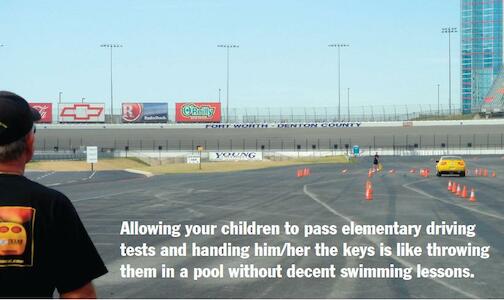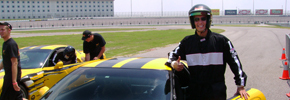News and Articles
Total Driving Experience: The Drive of Your Life

The Drive of Your Life
Rather than buying your kids golf clubs or lessons for the time being, invest in their lives
By Rick Arnett
"Never lend your car to anyone to whom you have given birth." — Erma Bombeck
Some of you are facing the same scary life-crisis situation as me: your lovely children are reaching the driving age. It’s their first real exposure to true independence – and your introduction to fretful, sleepless nights. While the kids are excited, we’re scared stiff. Newspapers are littered with fatality accidents involving someone’s beloved children. It’s a scenario that no parent should face – outliving your kids.
Unfortunately, the typical driving class these days woefully prepares young Johnny and Suzie with the necessary skills to confidently navigate the obstacles and sudden life-threatening situations on our roads.
We all remember our driver’s education classes when the football coach/shop teacher phoned in the sessions and passed students without the required stills. It’s sadly laughable to think learning parallel parking or turning blinkers is enough to handle today’s roads and countless reckless drivers. Fortunately, there’s a terrific c solution for the responsible (and worried) parent. Recently, my son, Matt, and I experienced what every young driver should attend before hitting the highways. The Texas Driving Experience at the Texas Motor Speedway provides a comprehensive hands-on session called the Teen and Adult Advanced Handling School. The class delivers essential hands-on skills and awareness to compete in the daily war of our public roads and highways. Owner Dawn Stokes and driving instructors John Barrentine and Reggie Hurry greeted us at their suite at the Speedway. Most of the other students were anticipating their licenses, but one sweet lady was my age (let’s just say 40-plus). The first part of the class focused on Barrentine delivering sobering stats that made us aware of how dangerous and foolhardy the average driver is.
Chew on these figures:
- 420 teenage drivers die each month.
- Cars are the leading cause of death for those ages 15-20.
- When carrying three or more passengers, the chance for a fatality increases 185 percent due to the additional distractions.
- Teenagers are four times more likely to die in car accident than the general population. Sixteen-year-olds are
- three times more likely.
- Driving while yakking on a cell phone is equal to a diminished attention span of two times the legal drinking limit – even hands-free.
- Hanging ornaments on the rearview mirror can cause serious injuries during an accident.
Darn scary, no? As our instructors mentioned, merely allowing your children to pass elementary driving tests and handing him/her the keys is like throwing them in a pool without decent swimming lessons. No one in their right mind would do that, yet every day parents send kids out without a clue how to drive a 1½ ton deadly weapon.
What’s interesting was discovering how ill prepared I was – even with 32 years of driving experience – to avoid the inevitable emergency.
After the classroom stint, it was time to hit the road. We began with the skid pad (Hydroplaning Correction) session, where the asphalt is wetted down. While making a turn, the instructor yanks the parking brake causing the backend to slide. The first instinct is to over-correct the skid and look away from your intended path. Ever wonder why a car hits a lone tree? It’s because we amazingly fixate on the very thing we’re trying to avoid. By training yourself to look at the desired path, your hands instantly follow the line of sight. That was a real eye-opener. After a couple of attempts, it was easy to master. I’m glad I never had the misfortune of facing that scenario before the lesson. Next, we were exposed to another dangerous scenario, getting run off the road onto the dirt or grass. Most would immediately attempt to steer back onto the street or highway. WRONG! Doing that makes the tires grab the asphalt, sending you careening across the road so another car can “T-bone” (broadside) your vehicle. The solution is to just coast along the path and slowly brake. Seems simple enough, unless you’ve faced it.
Another myth dispelled: Grab the wheel at the 9 and 3 o’clock positions, not 10 and 2. If the airbag goes off (it explodes at nearly 200 mph), arms at 10 and 2 will either get burned or broken. In addition, your shoulders won’t allow a 180-degree turn. I found the 9 and 3 also makes me significantly more alert than merely hanging one arm over the wheel. If you don’t believe me, look at a racecar’s steering wheel. The design only allows the 9 and 3 position. And you’ll never see a race driver palming the wheel either. It’s the little things that go a long way to raise your odds of avoiding a catastrophic situation.
The instructors showed us a simple trick to maximize your anti-braking system during panic stops. Adjust your seat so you still have knee fl ex when pushing to the floorboard. This ensures a full compression of the brake. It certainly helps experiencing the feel of a panic stop, so give it a shot in an empty parking lot. The emergency lane change taught us to steer first and then apply the brakes after avoiding danger. Sudden braking could cause an uncontrollable skid.
When at an intersection, wait a bit after the light turns green to make sure no one is running the red light. I can’t tell you how many times I’ve almost been blindsided by a clueless driver.
Navigating the slalom cones makes you look far ahead rather than concentrating on the most immediate cone. Slalom skiers apply the same technique, using their peripheral vision to set up turns down the course. Fixating on only the next cone makes you turn increasingly later for the latter ones. The same principle applies in normal driving. Look down the road for impending danger rather than concentrating on the brake lights immediately ahead. Finally, the obstacle course brought all the techniques together by combining hard braking, turning and slalom techniques. Matt had the fastest time, while I overshot the stopping target, costing me nearly seven seconds. It was an exhilarating experience, except when watching my kid screaming by with his hat backwards, a crazed grin and instructor Reggie holding on for dear life.
The six-hour class is a must for young and old. All too often you hear major injury or fatality accident announcements on the radio and obviously, none of the victims gave it a worried thought when awaking that fateful morning. Maybe they could’ve avoided fate if given some of these tools.
The instructors provide patience, savvy experience and a sense of humor. They’re passionate in their quest to make driving safer for yourself and everyone else. Amazingly, there are only four or five of these schools in the country. Parents should have the opportunity to give their kids the necessary experience to succeed and live. Wouldn’t a responsible parent help subsidize the program? We spend serious money on select travel teams but overlook a more pressing issue. Don’t give yourself a lifetime of regret by ignoring the opportunity. Son Matt said, “The class was exciting, enjoyable and humbling. I found out how little I knew and that paying attention is pretty important. It took all my concentration to avoid trouble, and that’s even when I was prepared for it.”
After a month since the class, I can honestly say my driving is safer, more aware and even downright enjoyable. Call
me crazy, but merely positioning my hands on the 9 and 3 makes tooling around fun again. I never thought I’d say that some 30 years removed from my teens. So, instead of first spending thousands of dollars for Junior’s car, how about investing roughly the equivalent of a new set of irons on improving your child’s chances of surviving their first six-cylinder rodeo? It’s an investment that lasts a lifetime. More importantly, it could allow that lifetime to reach a nice, long age.
Texas Driving Experience 817-430-4343
www.texasdrivingexperience.com
Rick Arnett also hosts the Teebox Golf
Show Saturday mornings from 8-10 on
Sportsradio 1310, The Ticket, and writes a
weekly column for CNNSI.com. E-mail him
at rick@avidgolferonline.com.

